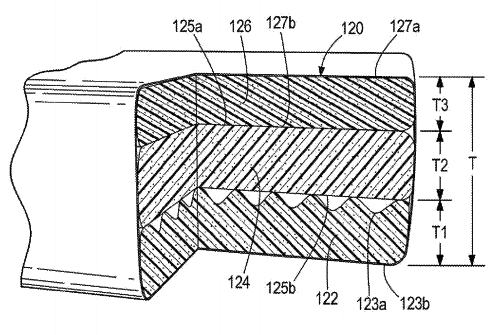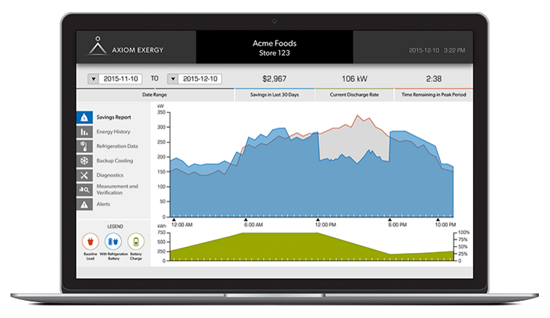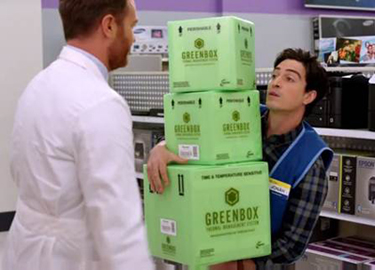 The Phase Change Matters e-mail newsletter is a weekly summary of the latest news and research on phase change materials and thermal energy storage. To subscribe, visit www.puretemp.com/subscribe. For more frequent updates, follow @puretemp on Twitter or visit the Phase Change Matters blog, www.puretemp.com/pcmatters.
The Phase Change Matters e-mail newsletter is a weekly summary of the latest news and research on phase change materials and thermal energy storage. To subscribe, visit www.puretemp.com/subscribe. For more frequent updates, follow @puretemp on Twitter or visit the Phase Change Matters blog, www.puretemp.com/pcmatters.
COMPANY NEWS
NETenergy, 5 other clean-tech startups join Wells Fargo Innovation Incubator
NETenergy of Chicago is one of six clean-technology startups selected to join the Wells Fargo Innovation Incubator, a five-year, $10 million program designed to accelerate innovative environmental technologies. The thermal energy storage company’s module integrates with air conditioning systems in small commercial buildings to shift energy demand and consumption to off-peak hours.
The other five companies are 7AC Technologies, Beverly, Mass.; Go Electric Inc., Anderson, Ind.; Heliotrope Technologies, Alameda, Calif.; Polyceed Inc., Encinitas, Calif.; and ThermoLift Inc., Stony Brook, N.Y.
Each company will receive up to $250,000 in cash and in-kind technical consultation. Innovation Incubator is funded by the Wells Fargo Foundation and co-administered by the U.S. Department of Energy’s National Renewable Energy Laboratory.
Thermal battery maker Axiom Exergy gears up for supermarket pilot projects
Axiom Exergy, maker of behind-the-meter thermal energy storage systems, has completed construction of a full-scale test system at its headquarters in Richmond, Calif., and is ramping up for pilot projects with major supermarket chains.
Axiom’s Refrigeration Battery is designed to reduce a supermarket’s peak power usage by up to 40 percent and provide backup cooling during power outages. The pilot projects are intended to show how the battery can shift the costly energy consumption of refrigeration systems to off-peak hours, substantially reducing a supermarket’s utility bills. Axiom plans to use the test facility to simulate load shifting, backup cooling and, in the near future, load reduction based on demand response signals from utility companies.
 “We offer an application-specific energy storage technology designed to store refrigeration,” said Amrit Robbins, Axiom president and co-founder. “Rather than ‘peak shaving,’ we move a significant amount of load for a long period of time, which is essential for facilities with large, relatively smooth refrigeration loads.”
“We offer an application-specific energy storage technology designed to store refrigeration,” said Amrit Robbins, Axiom president and co-founder. “Rather than ‘peak shaving,’ we move a significant amount of load for a long period of time, which is essential for facilities with large, relatively smooth refrigeration loads.”
The company also announced additions to its executive team and is closing a round of financing to pave the way for a Series A round of funding in 2016.
In an email interview, Robbins provided more detail on the Refrigeration Battery and the company’s future plans.
Q: In an interview with Greentech Media earlier this year, you mentioned a partnership with DOE’s National Renewable Energy Laboratory to vet Axiom’s technology models and performance data. Is that vetting complete? What are the results?
A: The National Renewable Energy Lab (NREL) reviewed our technical models and calculations for accuracy and completeness. They issued a report stating that “Axiom Exergy’s Refrigeration Battery is a promising, efficient energy storage solution for supermarkets and refrigerated facilities. Their modeling efforts are based on sound engineering principals and economic assumptions.”
Q: Help me visualize the inside of the storage tanks. Your website mentions “freezing a tank of water with common additives.” What are the additives? What is the freeze point of the water? How is the piping configured inside a tank?
A: The Refrigeration Battery system uses a standard, off-the-shelf, ice-on-coil tank with some proprietary modifications. The tank is filled with a proprietary salt-water eutectic solution that freezes at a relatively constant temperature that is well below 32 deg F. There is a polyethylene heat exchanger inside of the tank, and a heat transfer fluid (“coolant”) circulates within the heat exchanger. The coolant is used to remove heat from the tanks at night and reject heat into the tanks during the peak hours of the afternoon.
[For complete interview, visit the Phase Change Matters blog]
Greenbox shipper lands cameo role on ‘Superstore,’ a new NBC sitcom
In an effort to achieve prime time verisimilitude, the producers of “Superstore,” NBC‘s new workplace sitcom, stock the shelves of the fictional Cloud 9 store with everything from Zippo gift sets and Epson printers to Lipton tea and Seventh Generation toilet paper.
But the effort goes beyond a run to Target or Costco. When the script for Episode 3 called for boxes containing pharmaceuticals, a Google search led producers to thermosafe.com and a conversation with Sonoco ThermoSafe‘s marketing department.
“They weren’t really sure what they were looking for,” said Pete Infelise, Sonoco ThermoSafe marketing associate. “But I guided them through the process and we ended up with the Greenbox.”
The temperature-controlled shipper, developed by Entropy Solutions in 2007, is one of five Sonoco ThermoSafe packaging lines powered by PureTemp bio-based phase change material.
“Superstore,” starring America Ferrera (“Ugly Betty”) and Ben Feldman (“Mad Men”), officially premieres Jan. 4, but you can watch the first three episodes online.
AWARDS
Attention, young chemists: Application deadline is Feb. 8 for Reaxys PhD Prize
Submissions are now being accepted for the 2016 Reaxys PhD Prize. The international competition is open to Ph.D. students or recent graduates conducting innovative research in synthetic chemistry. Forty-five finalists will be selected based on originality of research, rigor of methodology, quality of published work and supervisor’s letter of recommendation. The application deadline is Feb. 8, 2016.
The finalists will present their research at the Reaxys PhD Prize Symposium. Three winners will then be selected and receive $2,000.
The 2015 winners:
• Andrew Jupp, University of Oxford, “Reactivity of the 2-phosphaethynolate anion and phosphinecarboxamide”
• John Tellis, University of Pennsylvania, “Single-Electron Transmetalation: Enabling C(sp3) Cross-Coupling via Photoredox/Nickel Dual Catalysis”
• Shin-nosuke Uno, University of Tokyo, “A spontaneously blinking fluorophore based on intramolecular spirocyclization for live-cell super-resolution imaging”
Nominations due Dec. 31 for Presidential Green Chemistry Challenge Awards
The U.S. Environmental Protection Agency is accepting nominations for the 2016 Presidential Green Chemistry Challenge Awards. Companies or institutions that have developed a process or product that better protects public health and the environment are eligible.
Nominations will be accepted through Dec. 31, 2015. There are six award categories this year:
• Greener Synthetic Pathways
• Greener Reaction Conditions
• The Design of Greener Chemicals
• Small Business
• Academic
• Specific Environmental Benefit: Climate Change
Dr. William R. Sutterlin, Entropy Solutions‘ chief science officer, was a member of a University of Missouri team that won the academic award in 2006 for developing an inexpensive method to convert waste glycerin, a byproduct of biodiesel fuel production, into propylene glycol.
Virginia power plant with TES cooling is Gas-Fired Project of the Year
Dominion Virginia Power‘s newest power station has been named Gas-Fired Project of the Year by the editors at Power Engineering and Renewable Energy World magazines. The 1,329-megawatt, natural gas-fueled Warren County Power Station can generate enough electricity to fuel about 325,000 homes. Features include a thermal energy storage system to chill the air supply for the combustion turbines.
PHASE CHANGE MATERIALS
Passive technologies help Fort Irwin Training Center cut energy use
Kristen Victor, CEO of Sustainability Matters, explains how her company helped Fort Irwin National Training Center use phase change materials and other passive technologies to reduce energy use at the 20-building complex in the California desert.
“The overall energy usage reduction combined with the described strategy is 37 percent energy reduction on the cooling load during the moderate summer/fall months,” Victor writes. “Continuous data collection will focus on the heating/gas usage reduction in the winter months and the extreme heat of the intense summer months through a 12-month M&V cycle. In [addition] to the energy reduction, the barracks are a moderately consistent temperature, providing the human occupant, our soldiers, a much more comfortable environment.”
PCM-powered device keeps vaccines cool in hot climates
The refrigeration needed to keep vaccines safe and effective can be hard to come by in rural Nigeria, Nepal and other remote parts of the world. Global Good — a collaborative effort between Bill Gates and Intellectual Ventures — has devised one solution. The Arktek passive cooling device uses phase change materials to hold temperatures between 0 and 10 degrees Celsius for a minimum of 35 days in a hot climate.
IN BRIEF
• German researchers are working on a thermal storage system that uses lime as the storage medium.
• Representatives of three district energy champion cities – St. Paul, Minn., and two Swedish cities, Malmö and Gothenburg – shared their success stories at the climate conference in Paris.
• A new report from Technavio, “Global Advanced Energy Storage Systems 2016-2020,” projects that market will see a compound annual growth rate of nearly 14 percent over the next five years.
• New research by Future Market Insights, “Temperature Controlled Packaging Solutions Market: Global Industry Analysis and Opportunity Assessment 2015-2025,” will be published in January.
• Take a look inside Qatar Cool‘s new District Cooling Plant 3, which will feature a thermal energy storage tank with a 5,000-ton cooling capacity.
• TechNiche Europe has introduced a washable version of its HyperKewl cooling fabric.
PATENTS

Multilayer body support having phase change material
U.S. patent application 20150351557 (assignee Sealy Technology LLC, Trinity, N.C.):“A body support includes a plurality of vertically stacked layers, a phase change material provided in each of the layers, and a cover enclosing the vertically stacked layers. … The invention provides, in other aspects, a body support including a plurality of foam layers, at least one of which is a high-resilience foam, and a phase change material provided within the high-resilience foam layer.”
Method and apparatus for thermal actuating, unactuating downhole tools
U.S. patent application 20150354304 (assignee Baker Hughes Inc., Houston):
“A method for actuating a downhole tool comprising disposing a phase change material having selected volumetric change upon phase change in contact with a tool or tool component. Raising a temperature of the material above the phase change point of the material. Directing a resultant force of the volumetric increase of the phase change material to the tool or tool component.”
RESEARCH ROUNDUP
For our full list of recent academic research, see puretemp.com/academic. Here are highlights from the past week:
From Energy and Buildings:• Economic impact of integrating PCM as passive system in buildings using Fanger comfort model
• Development and performance evaluation of heat storage paint with MPCM for applying roof materials as basic research
From Applied Thermal Engineering:
• A comparative study on PCM and ice thermal energy storage tank for air-conditioning systems in office buildings
• A comparative study of thermal behaviour of a horizontal and vertical shell-and-tube energy storage using phase change materials
• Binary mixtures of fatty acid methyl esters as phase change materials for low temperature applications
From Energy Procedia:
• Identification of Design Criteria for District Cooling Distribution Network with Ice Thermal Energy Storage System
From Carbon:
• A Pickering emulsion route to a stearic acid/graphene core–shell composite phase change material
• The use of graphite foams for simultaneous collection and storage of concentrated solar energy
From Advances in Building Energy Research:
• Numerical simulation of phase change materials for building applications: a review
From International Journal of Heat and Mass Transfer:
• Experimental and numerical study on transient thermal energy storage of microencapsulated phase change material particles in an enclosure
From Fibers and Polymers:
• FE Analysis of Thermal Properties of Woven Fabric Constructed by Yarn Incorporated with Microencapsulated Phase Change Materials [pdf]
From Renewable Energy:
• Thermal characterization of phase change materials based on linear low-density polyethylene, paraffin wax and expanded graphite
NETWORKING
Connect with PCM experts and industry leaders on LinkedIn
More than 450 of your peers have joined a new LinkedIn group devoted to the discussion of phase change material and thermal energy storage. The Phase Change Matters group is an interactive complement to the award-winning blog and newsletter of the same name.
You are invited to join the group and connect with PCM and TES experts from around the world. New members this week include Ioannis Anastasakis, owner of TechNiche International, San Diego; Isabella Trani, who is studying design at Loughborough University, U.K.; Anirudh Batra, business development associate at Pluss Advanced Technologies, India; and Ron Nagar, co-founder of a medical device company in Israel.
YOUR TURN
Got a question about PCMs or TES? Ask our experts
Two Entropy Solutions advisors, Dr. Mohammed Farid of the University of Auckland and Lucas B. Hyman of Goss Engineering, are ready to answer your questions about phase change material and thermal energy storage. We’ll select the best questions sent to bwelter@puretemp.com and post the answers here each Friday.


